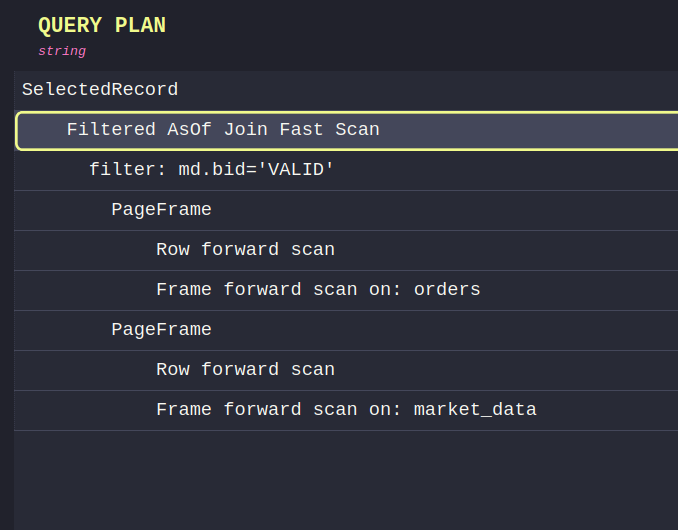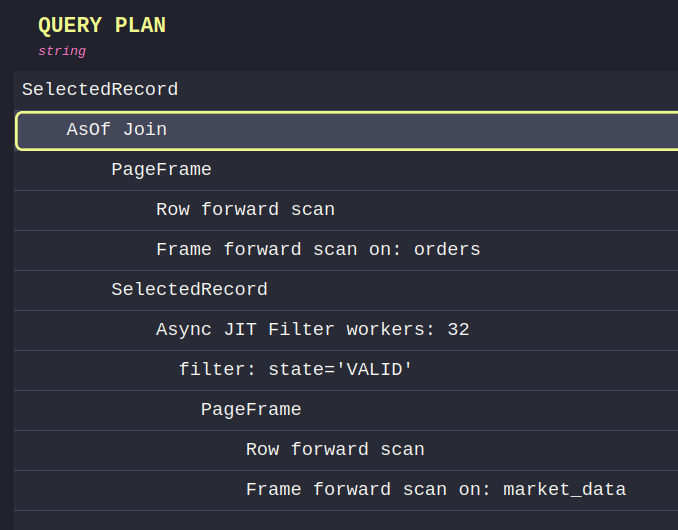SQL optimizer hints
QuestDB's query optimizer automatically selects execution plans for SQL queries based on heuristics. The default execution strategy should be the fastest for most datasets. You may use hints to select a specific execution strategy which may (or may not) outperform the default strategy. SQL hints influence the execution strategy of queries without changing their semantics.
Hint Syntax
In QuestDB, SQL hints are specified as SQL block comments with a plus sign after the opening comment marker. Hints must be placed immediately after the SELECT keyword:
SELECT /*+ HINT_NAME(parameter1 parameter2) */ columns FROM table;
Hints are entirely optional and designed to be a safe optimization mechanism:
- The database will use default optimization strategies when no hints are provided
- Syntax errors inside a hint block won't fail the entire SQL query
- The database safely ignores unknown hints
- Only block comment hints (
/*+ HINT */) are supported, not line comment hints (--+ HINT)
Available Hints
USE_ASOF_BINARY_SEARCH
The USE_ASOF_BINARY_SEARCH hint enables a specialized binary search optimization for
non-keyed ASOF joins when filtering is applied to the joined table. This hint requires two
parameters that specify the table aliases participating in the join.
SELECT /*+ USE_ASOF_BINARY_SEARCH(orders md) */
orders.ts, orders.price, md.md_ts, md.bid, md.ask
FROM orders
ASOF JOIN (
SELECT ts as md_ts, bid, ask FROM market_data
WHERE state = 'VALID' --filter on the joined table
) md;
How it works
By default (without this hint), QuestDB processes ASOF joins by:
- Applying filters to the joined table in parallel
- Joining the filtered results to the main table
With the USE_ASOF_BINARY_SEARCH hint, QuestDB changes the execution strategy:
- For each record in the main table, it uses binary search to locate a record with a matching timestamp in the joined table
- Starting from this located timestamp match, it then iterates backward through rows in the joined table, in a single thread, until finding a row that matches the filter condition

When to use
This optimization is particularly beneficial when:
- The joined table is significantly larger than the main table
- The filter on the joined table has low selectivity (meaning it doesn't eliminate many rows)
- The joined table data is likely to be "cold" (not cached in memory)
When joined table data is cold, the default strategy must read all rows from disk to evaluate the filter. This becomes especially expensive on slower I/O systems like EBS (Elastic Block Storage). The binary search approach significantly reduces I/O operations by reading only the specific portions of data needed for each join operation.
However, when a filter is highly selective (eliminates most rows), the binary search strategy may be less efficient. This happens because after finding a timestamp match, the strategy must iterate backward in a single thread, evaluating the filter condition at each step until it finds a matching row. With highly selective filters, this sequential search may need to examine many rows before finding a match.
As a rule of thumb, the binary search strategy tends to outperform the default strategy when the filter eliminates less than 5% of rows from the joined table. However, optimal performance also depends on other factors such as the ratio between main and joined table sizes, available hardware resources, disk I/O performance, and data distribution.
In contrast, the default strategy processes and filters the joined table in parallel, which can be much faster for highly selective filters despite requiring an initial full table scan.
Execution Plan Observation
You can verify how QuestDB executes your query by examining its execution plan
with the EXPLAIN statement:
EXPLAIN SELECT /*+ USE_ASOF_BINARY_SEARCH(orders md) */
orders.ts, orders.price, md.md_ts, md.bid, md.ask
FROM orders
ASOF JOIN (
SELECT ts as md_ts, bid, ask FROM market_data
WHERE state = 'VALID'
) md;
When the hint is applied successfully, the execution plan will show a Filtered AsOf Join Fast Scan operator, confirming that the binary search strategy is being used:

For comparison, here's what happens without the hint:
EXPLAIN SELECT
orders.ts, orders.price, md.md_ts, md.bid, md.ask
FROM orders
ASOF JOIN (
SELECT ts as md_ts, bid, ask FROM market_data
WHERE state = 'VALID'
) md;
The execution plan will show:
- A standard
AsOf Joinoperator instead ofFiltered AsOf Join Fast Scan - A separate filtering step that processes the joined table in parallel first
